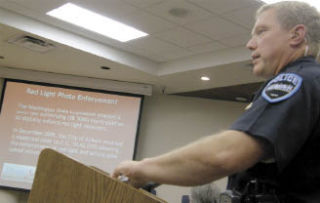Auburn Police Chief Jim Kelly drew gasps, oohs and ahhs in City Council chambers early last week when he showed video clips of red light runners ploughing unlawfully through city intersections and almost smashing into vehicles lawfully there.
One clip, however, which showed the image of a police car following a scofflaw in the act, received a different reaction.
“This violator gets to meet one of our black and whites,” Kelly said to applause and cheering.
Kelly was there to update city officials on the red light photo enforcement program that went live in Auburn on July 1, 2006. Photo enforcement cameras are operating in the north- and south-bound lanes of Fourth and Auburn Way South, at M Street and Auburn Way South and at 8th Street and Harvey Road. The city also has expanded the program to cut down speeding in designated school zones at Dick Scobee and Chinook elementaries and at Mt. Baker Middle School.
Kelly said the data show that fewer people are running red lights at Auburn intersections that have been equipped with photo enforcement cameras and that right angle or t-bone collisions are down since the cameras went live. In fact there were a total of 5,395 violations at these intersections, with 4,718 infractions issued between July 2007 and January 2008. Overall violations per month are down from 870 per month in the first 13 months to 770 as of January of this year at all the intersections. Violations are down by an average of 40 percent at all locations since the cameras went live.
A car that crosses the stop line on a red light or exceeds 20 mph in a designated school speed zone signals cameras to snap a picture and make a video clip, which is sent electronically to the system’s owner, Redflex Traffic Systems, in Flagstaff, Ariz. Redflex sends these clips to Auburn police for review the next day, and it is officers who make the actual determination whether facts sufficient or grounds exist to issue an infraction.
Police reject about 14 percent of the violations that are captured on camera, down from a high of 20 percent during the first three months of operation, Kelly said. Police can reject a violation for a number of reasons, from a malfunctioning flash system, which may not clearly pick up the license plate or be blurry, to emergency vehicles that are lawfully running the red light or speeding in a school zone. And sometimes a driver makes a U-turn in an intersection, which may be legal but still registers as an improper turn.
Once the violation meets police standards for validation, the officer sends it over the Internet to Redflex, which mails the violation notice to the registered owner along with a web address where the owner can view a photo and video clip of the infraction. The infraction does not go on the driving record.
From July 1, 2006 to July 1, 2007, 2,803 owners asked for mitigation hearings from Auburn Municipal Court, representing 22 percent of the total number of infractions issued during the same time period. Of those infractions contested, 848 were dismissed, a rate of 30 percent. Between July 1, 2007 and Feb. 29, 2008, 3,110 people asked for a mitigation hearing. Of those infractions contested, 1,173 (37.7 percent) were dismissed.
Courts in other jurisdictions allow the registered owner to send in an affidavit or letter to the court asserting that he or she was not driving the car, but Auburn’s court demands as a condition of dismissal that the owner swear under penalty of perjury before a judge that he or she was not operating the vehicle.
When an officer issued the ticket, 50 percent ask for such a hearing.
“What is I think most valauble to this is that citizens can actually go on line and view a video depicting the alleged violation,” Kelly said. “I’m certain that encourages a lot of motorists to handle the infraction different than than they would have if the officer is going to go to court to testify.”
The city and Redflex are working together to locate intersections and school zones throughout the city, including the newly annexed areas, that could be candidates for additional cameras.



